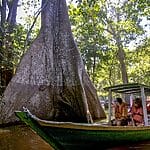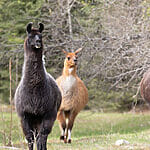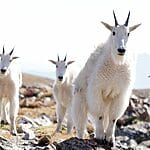11 Interesting Animals in Argentina – You Might Not Know
Do you know that a diverse range of interesting animals are inhabiting Argentina? From the striking landscapes of the Andes Mountains to the expansive grasslands of the Pampas, there are many interesting animals in Argentina.

In the lush north, you can spot the mysterious jaguar, stealthily prowling through thick rainforests. Meanwhile, in the southern reaches, the captivating guanaco, a close relative of the llama, gracefully traverses the windswept Patagonian steppes.
The Andean condor, one of the world’s largest flying birds, soars majestically over the dramatic mountain landscapes. And that’s not all—armadillos, Andean flamingos, and the rare vicuña add even more charm to the wildlife of Argentina.

Do you know Argentina is the second-largest country in South America after Brazil, and the eighth-largest country in the world.
List of 11 Interesting Animals in Argentina – (With Interesting Pictures)
Argentina is home to a remarkable array of interesting animals, showcasing the country’s diverse ecosystems. In the vast Patagonian region, you can spot the iconic guanaco roaming the open steppes alongside the lesser-known mara, a large herbivorous rodent.
Moreover, Argentina’s wetlands and marshes harbor the capybara, the world’s largest rodent, and the striking black-necked swan. Along the coasts, orcas and southern right whales make their seasonal appearances, captivating observers with their graceful movements.
But there are more interesting animals on the list which we have listed below, and are worth exploring.
Pink Fairy Armadillo
Scientific Name: Chlamyphorus truncatus
Diet: Insectivore
Conservation status: Data deficient

The Pink Fairy Armadillo, native to central Argentina, is a fascinating creature inhabiting dry grasslands and sandy plains. These interesting animals in Argentina also inhabit parts of Uruguay, Paraguay, and Bolivia.
This diminutive species, measuring around 3.5 to 4.5 inches in length, boasts a unique appearance with its pale pink armor-like shell, adapted for burrowing underground.
The Pink Fairy Armadillo have a small, flattened body encased in a flexible shell, aiding in swift movement through loose soil. Its large front claws are adept at digging intricate tunnel systems where it seeks refuge from the scorching daytime heat.
An interesting fact about these armadillos is their ability to regulate their body temperature, keeping cool underground by reducing blood flow to their extremities.
As a result, the Pink Fairy Armadillo is classified as “Near-threatened” on the IUCN Red List. Unfortunately, the Pink Fairy Armadillo faces significant threats to its survival, including habitat destruction due to agriculture and urbanization
Tree Iguana /Green Iguanas
Scientific name: Iguana arborescens
Diet: Herbivorous
Conservation status: Endangered Species

Tree iguanas, also known as green iguanas (Iguana iguana), are one of the most interesting animals in argentina. Commonly found in the tropical rainforests of Central and South America, including some other countries like Mexico, Brazil, and Costa Rica. Their natural habitats are lush dense forests, riverbanks, and coastal areas.
These arboreal reptiles are well-adapted to life in the trees, using their strong limbs and long tails for climbing and maintaining balance. Tree iguanas are characterized by their vibrant green coloration, which provides effective camouflage in the dense foliage of their habitats.
They have a robust body with a crest of spines running down their back and a dewlap, a flap of skin under their chin, which is often brightly colored and used for communication.
One interesting behavior of tree iguanas is their basking ritual. These reptiles often spend significant amounts of time sunbathing on branches to regulate their body temperature.
River Otter
Scientific name: Lontra canadensis
Diet: Carnivorous
Conservation Status: Endangered species

River otters are one of the interesting animals in Argentina. and semiaquatic mammals found in various regions of North America, including rivers, lakes, ponds, and coastal areas.
They live in a variety of aquatic environments, from freshwater streams to marshes and estuaries. River otters are highly adaptable and can thrive in both freshwater and coastal ecosystems.
These otters have a streamlined body, webbed feet, and a thick, water-repellent fur coat that helps to insulate them in cold water. Their fur is usually dark brown, with a lighter underside, and they possess a long, tapered tail that helps in swimming and navigating through the water.
One interesting behavior of river otters is their playful and social nature. They are known for engaging in playful activities, such as sliding down riverbanks, chasing each other, and participating in mock fights.
Andean Mountain Cat – Wild Cat
Andean mountain cat scientific name: Leopardus jacobita
Diet: Carnivorous

Andean mountain cats are one of the most interesting animals in Argentina. This small wild cat is rare and native to the high-altitude regions of the Andes Mountains in South America.
Their range spans several countries, including Peru, Bolivia, Chile, and Argentina. These mountain cats usually live in terrains, including the barren landscapes of the high Andean plateaus and the rocky slopes of the mountains.
The Andean mountain cat can be recognized by its striking coat. Their fur is dense, long, and soft, featuring a background color that ranges from pale silvery-gray to a yellowish-brown, adorned with irregular dark brown or black markings.
They have a robust build with a short tail and relatively short legs, which clearly shows their adaptations to the mountainous habitat. Additionally, on the IUCN Red List of threatened species Andean mountain cats are categorized as “Endangered species.”
Patagonian Mara
Scientific Name: Dolichotis patagonum
Diet: Herbivores
Conservation Status: Near Threatened

It is a large rodent species native to the grasslands and open habitats of Argentina, particularly in the Patagonian region. Patagonian Marais one of the interesting animals in Argentina that are found in different parts of Chile, where they inhabit areas with suitable vegetation and a semi-arid climate.
You can spot Patagonian Maras by their unique and charming appearance. They have robust body, with long, slender legs adapted for fast running. Their body is covered with dense fur and can vary in color, ranging from light brown to grayish-brown.
They have distinctive facial features, including large eyes and long ears that can be moved independently, adding to their endearing appearance.
Some Interesting Aquatic Animals in Argentina – Where to find them
Animals in Argentina are an attraction in itself. Argentina is dotted with areas that have stunning open spaces for friendly fauna to wander around freely. Additionally, there are many wildlife sanctuaries to protect the beautiful animals in Argentina in their native land you can support with your visit. Read more about it.
Peninsula Valdes – Whale Watching, Seals, And Penguins
It is the Valdes peninsula on Patagonia’s Atlantic coast. If you want an amazing Patagonia animal experience, stay at Puerto Piramides.
Sea Lion
Scientific Name: Zalophus Californianus
Diet: Carnivores
Conservation Status: Least Concern

Sea lions are interesting animals in Argentina and are marine mammals found in various locations around the world. They live in coastal areas of North and South America, Europe, Australia, and Africa. They live in various kinds of environments, which include rocky coastlines, sandy beaches, islands, and offshore rocks.
Sea lions are well-adapted to both temperate and tropical waters, and their colonies can be seen basking on shorelines or swimming in coastal waters.
They have streamlined bodies, long foreflippers, and external ear flaps, which separate them from true seals. Sea lions have various body shades, from light brown to dark tan, and some sea lion species display sexual dimorphism, with males being larger and having prominent manes.
Flying Fish
Scientific Name: Exocoetidae
Diet: Omnivores
Conservation status: Least concern

Flying fishes are one of the interesting animals in Argentina, and found in the Pacific, and South Atlantic oceans, commonly in tropical and subtropical waters. Their natural habitats include the open sea, where they inhabit the upper part.
These fishes are known for their unique appearance, characterized by elongated pectoral fins that function like wings. Their fins help them to glide above the water’s surface, providing a remarkable adaptation for escaping predators.
They have a streamlined body with silvery scales and have large pectoral fins. These fins are adapted for gliding, while a forked tail helps in propulsion through the water. The lower lobe of the tail is often larger, contributing to stability during flight.
Southern Right Whale
Scientific Name: Eubalaena australis
Diet: Carnivores
Conservation status: Endangered

The Southern Right Whale (Eubalaena australis) is found in the southern hemisphere, with populations inhabiting cold and temperate waters. Their natural habitats include sub-Antarctic and Antarctic regions, as well as coastal waters near South America, South Africa, Australia, and New Zealand.
These interesting animals in Argentina are known to migrate to specific breeding and calving grounds, often approaching shallow, sheltered bays during the breeding season.
Southern Right Whales are large, baleen-filter-feeding cetaceans with distinctive features. They have a robust, dark-colored bodies, and their heads are adorned with callosities and rough patches of raised skin that vary in shape and size.
Where to find Interesting Bird Species in Argentina?
Argentina is home to numerous unique and endemic bird species that make it a standout location for bird watching. Among the notable species is the Andean condor, the national bird of Argentina, which you can spot in the Andean regions.
The strikingly colorful Andean flamingo and the elusive Hooded Grebe are some of the other distinctive bird species found in Argentina.

The bird population in Argentina is extensive, with over 1,000 recorded species. Some best birdwatching hotspots in Argentina are the national parks which include Iberá Wetlands, the Valdes Peninsula, and El Palmar National Park.
White Monjita
Scientific Name: Xolmis irupero
Diet: Carnivore
Conservation status: Threatened Species

The White Monjita (Xolmis irupero) is a striking bird species found in South America, specifically in countries such as Argentina, Brazil, Paraguay, and Uruguay. These bird species inhabit a variety of open habitats, including grasslands, savannas, and agricultural areas. They are often seen perching on fences or wires, scanning their surroundings for prey.
The White Monjita is known for its distinct black and white plumage. The upper parts of the bird are black, contrasting sharply with the pure white underparts.
Their black facial mask extends from the bill to the nape, giving them a distinctive and appealing appearance. This coloration serves both for camouflage in their open habitat and for communication.
Andean Condor
Andean Condor scientific name: Vultur gryphus
Diet: Scavenger
Conservation status: Vulnerable the Andean condor

The Andean Condor (Vultur gryphus) is native to South America, and found in the Andes mountain range. Their range spans from Venezuela in the north to Chile and Argentina in the south. They are commonly found in high-altitude regions, soaring over mountainous landscapes, deep canyons, and rocky cliffs.
The Andean Condors are interesting animal species known for their impressive size and striking features. It boasts a massive wingspan, often exceeding 10 feet, making it one of the largest flying birds globally.
The plumage is predominantly black, and adult condors exhibit a distinctive ruff of white feathers surrounding their neck. They also have a large white triangular patch on their wings.
Rufous Hornero – National Bird of Argentina
Scientific Name: Furnarius rufus
Diet: Carnivorous
Conservation Status: Endangered Animals

Rufous Hornero are interesting animals in Argentina and medium-sized birds with a length ranging from 18 to 20 centimeters. It is a national bird of Argentina that exhibits a distinct reddish-brown plumage, from which it derives its name.
The upper parts of the bird are adorned with rufous tones, creating a warm and earthy appearance. The underparts are generally paler, contributing to a well-camouflaged look in the grassy and in arid habitats it often inhabits.
List of Endangered Animals in Argentina.
Many interesting animals in Argentina are marked as endangered, as their population is declining with each passing year. Some of them are mentioned below.
- Andean Cat (Oreailurus jacobita).
- Blue Whale (Balaenoptera musculus).
- Chacoan Peccary (Catagonus wagneri).
- Fin Whale (Balaenoptera physalus).
- Giant Armadillo (Priodontes maximus).
- Giant Otter (Pteronura brasiliensis).
Frequently Asked Questions about Interesting Animals in Argentina
What is the unique animal in Argentina?
Patagonian mara is a unique animal in Argentina.
What is the national animal in Argentina?
Rufous hornero is the national animal in Argentina.
Does Argentina have wild animals?
Argentina is home to many wild animals. Some of them are the Andean Condor, Puma, Jaguar, Guanaco, Southern Right Whale, and Magellanic Penguin.
What predators are there in Argentina?
Jaguars and Cougars are the land predators in Argentina, however, they avoid contact and interaction with humans. Additionally, you must be cautious with the venomous snakes, and spiders in Argentina.
Does Argentina have wild animals?
The lush vistas surrounded by dense forests are filled with wildlife. It also hosts many wild animals, such as anacondas, jaguars, and howler monkeys.
- 12 Interesting Animals in Dominican Republic - 2024-05-02
- 8 Common Dangerous Animals in Yosemite - 2024-05-01
- 11 Interesting Animals in the Midwest - 2024-05-01









